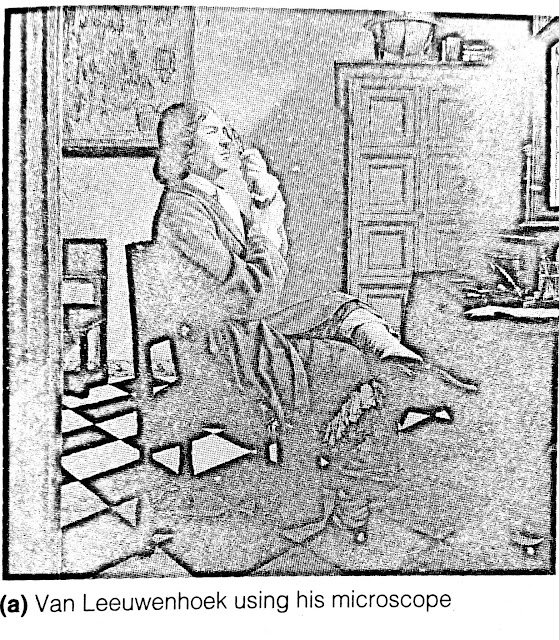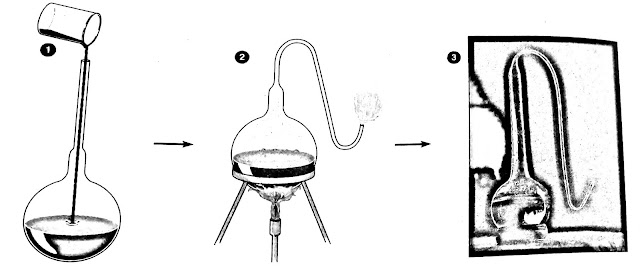The science of microbiology datee back
only 2 hundred years yet the recent discovery of Mycobacterium tuberculosis DNA
in 3000 year old Egyptian mummies remind us that microorganisms have been
around for much longer. In fact bacterial ancestors were the first living cells
to appear on Earth. While we know relatively little about what earlier people
thought about the causes transmission and treatment of disease the history of
the past few hundred years is better know. Lets look now at some key
development in microbiology that have helped the fields progress to its current
high technology state.
THE FIRST OBSERVATIONS
One of the most important discoveries in
the history of biology occurred in 1665 with the help of a relatively crude
microscope. After observing thin slice of cork an English man Robert hooke
reported to the world that lifes smallest structural units were little boxes or
cells as he called them. Using his improved version of a compound
microscope Hooke was able to see individual cells. Hookes discovery
marked the beginning of the cell theory the theory that all living things are
composed of a cells. Subsequent investigations into the structure and functions
of cells were based on this theory.
Thousands hookes microscope was capable of showing cells he lacked the staining techniques that would have allowed him to see microbes clearly. The Dutch merchant and amateur scientist Anton van Leeuwenhoek was probably the first to actually observe live microorganisms through the magnifying lenses of more than 400 microscopes he constructed. Between 1673 and 1723 he wrote a series of latters of the Royal Society of London describing the animalcules he saw through his simple single lens microscope. Van Leeuwenhoek made detailed drawing of animalcules in rainwatervin hos own feces and in material scraped from his teeth.
Thousands hookes microscope was capable of showing cells he lacked the staining techniques that would have allowed him to see microbes clearly. The Dutch merchant and amateur scientist Anton van Leeuwenhoek was probably the first to actually observe live microorganisms through the magnifying lenses of more than 400 microscopes he constructed. Between 1673 and 1723 he wrote a series of latters of the Royal Society of London describing the animalcules he saw through his simple single lens microscope. Van Leeuwenhoek made detailed drawing of animalcules in rainwatervin hos own feces and in material scraped from his teeth.
These drawings have since been
identified as representations of bacteria and protozoa.
 |
| VAN LEEUWENHOEK USING HIS MICROSCOPE |
(a). By holding his brass microscope
toward a source of light van Leeuwenhoek was able to observe living organisms
too small to be seen with the unaided eye.
(b). The specimen was placed on the tip of
the adjustable point and viewed from the other Side through the tiny nearly
spherical lens. The highest magnification possible with his microscopes was
about 300× .
 |
| MICROSCOPE REPLICA |
(c). Some of van Leeuwenhoeks drawings of
bacteria males in 1683. The letters represent various shapes of
bacteria. C - D represents a
path of motion he observed.
 |
| DRAWINGS OF BACTERIA |
THE DEBATE OVER SPONTANEOUS GENERATION
After van Leeuwenhoek discovered the
previously invisible world of microorganisms the scientific community of the
time because interested in the origins of these tiny living things. Untile the
second half of the nineteenth century many scientists and philosophers believed
that some forms of life could arise spontaneously from nonliving matter they
called this hypothetical process spontaneous generation. Not much more
than 100 years ago people commonly believed that toads snakes and mice could be
born in moist soil that flies could emerge from manure and that maggots the
larvae of flies could arise from decaying corpses.
EVIDENCE PRO AND CON
A strong apponent of spontaneous
generation the Italian physician Francesco Redi set out in 1668 ( even
before van Leeuwenhoek discovery of microscopic life) to demonstrate that
maggots did not arise spontaneously from decaying meat. Redi filled 2 jars with
decaying meat.
The first was left unsealed the flies laid their eggs on the meat and the eggs developed into larvae. The second jar was sealed and because the flies could not lay their eggs on the meat no maggots appeared. Still Redis antagonists were not convinced they claimed that fresh air was needed for spontaneous generation. So Redi set up a second experiment in which a jar was covered with a fine net instead of being sealed. No larvae appeared in the gauze coverd jar even though air was present. Maggots appeared only when flies were allowed to leave their eggs on the meat. Redis result were a serious blow to the long held be lief that large forms of life could arise from nonlife. However many scientists still believed that small organism such as van Leeuwenhoek animalcules were simple enough to be generated from nonliving materials.
The first was left unsealed the flies laid their eggs on the meat and the eggs developed into larvae. The second jar was sealed and because the flies could not lay their eggs on the meat no maggots appeared. Still Redis antagonists were not convinced they claimed that fresh air was needed for spontaneous generation. So Redi set up a second experiment in which a jar was covered with a fine net instead of being sealed. No larvae appeared in the gauze coverd jar even though air was present. Maggots appeared only when flies were allowed to leave their eggs on the meat. Redis result were a serious blow to the long held be lief that large forms of life could arise from nonlife. However many scientists still believed that small organism such as van Leeuwenhoek animalcules were simple enough to be generated from nonliving materials.
 |
| PASTEURS EXPERIMENT |
(1). Pasteur first poured beef broth into
a long nacked flask.
(2). Next he heated the neck of the flask
and bent it into an S shaped curve then he boiled the broth for several minuts.
(3). Microorganisms did not appear in the
cooled solution even after long periods as you can see in this recent
photograph of an actual flask used by pasteur in a similar experiment.
GOLDEN AGE OF MICROBIOLOGY





0 comments:
Post a Comment